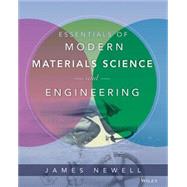
Note: Supplemental materials are not guaranteed with Rental or Used book purchases.
Purchase Benefits
What is included with this book?
| Introduction: Why Study Materials Science? | |
| Overview of Materials Science: What Issues Impact Materials Selection and Design? | |
| Property Considerations for Specific Applications | |
| Impact of Bonding of Material Properties | |
| Changes of Properties over Time | |
| Impact of Economics on Decision Making | |
| Sustainability and Green Engineering: What Choices Are Available? | |
| Classes of Materials | |
| Structure in Materials: How Are Atoms Arranged in Materials? | |
| Introduction | |
| Level of Order | |
| Lattice Parameters and Atomic Packing Factors | |
| Density Estimations | |
| Crystallographic Planes | |
| Miller Indices: How Are Crystals Measured? | |
| X-Ray Diffraction | |
| Microscopy: How Do Crystals Form and Grow? | |
| Nucleation and Grain Growth: What Kinds of Flaws Are Present in Crystals and What Do They Affect? | |
| Point Defects | |
| Dislocations | |
| Slip | |
| Dislocation Climb: What New Developments Are Happening with Crystals and Crystal Structures? | |
| Monocrystals and Nanocrystals | |
| Measurement of Mechanical Properties: How Do I Know How to Measure Properties? | |
| ASTM Standards: What Properties Can Be Measured, and What Do They Tell Me? | |
| Tensile Testing | |
| Compressive Testing | |
| Bend Testing | |
| Hardness Testing | |
| Creep Testing | |
| Impact Testing: Will I Get the Same Result Every Time I Run a Specific Test? | |
| Error and Reproducibility in Measurement: Why Do Materials Fail Under Stress? | |
| Fracture Mechanics: How Do Mechanical Properties Change Over Time? | |
| Fatigue Testing | |
| Accelerated Aging Studies | |
| Metals: How Do You Work with Metals? | |
| Forming Operations: What Advantages Do Alloys Offer? | |
| Alloys and Phase Diagrams | |
| Carbon Steel | |
| Phase Transitions | |
| Age Hardening (Precipitation Hardening) | |
| Copper and Its Alloys | |
| Aluminum and Its Alloys: What Limitations Do Metals Have? | |
| Corrosion: What Happens to Metals after Their Commercial Life? | |
| Recycling of Metals | |
| PolymersWhat Are Polymers? | |
| Polymer Terminology | |
| Types of Polymers: How Are Polymer Chains Formed? | |
| Addition Polymerization | |
| Condensation Polymerization | |
| Importance of Molecular Weight Distributions: What Influences the Properties of Polymers? | |
| Constitution | |
| Configuration | |
| Conformation | |
| Additives: How Are Polymers Processed into Commercial Products? | |
| Polymer Processing: What Happens to Polymers When They Are Discarded? | |
| Recycling of Polymers | |
| Ceramics and Carbon Materials: What Are Ceramic Materials? | |
| Table of Contents provided by Publisher. All Rights Reserved. |
The New copy of this book will include any supplemental materials advertised. Please check the title of the book to determine if it should include any access cards, study guides, lab manuals, CDs, etc.
The Used, Rental and eBook copies of this book are not guaranteed to include any supplemental materials. Typically, only the book itself is included. This is true even if the title states it includes any access cards, study guides, lab manuals, CDs, etc.